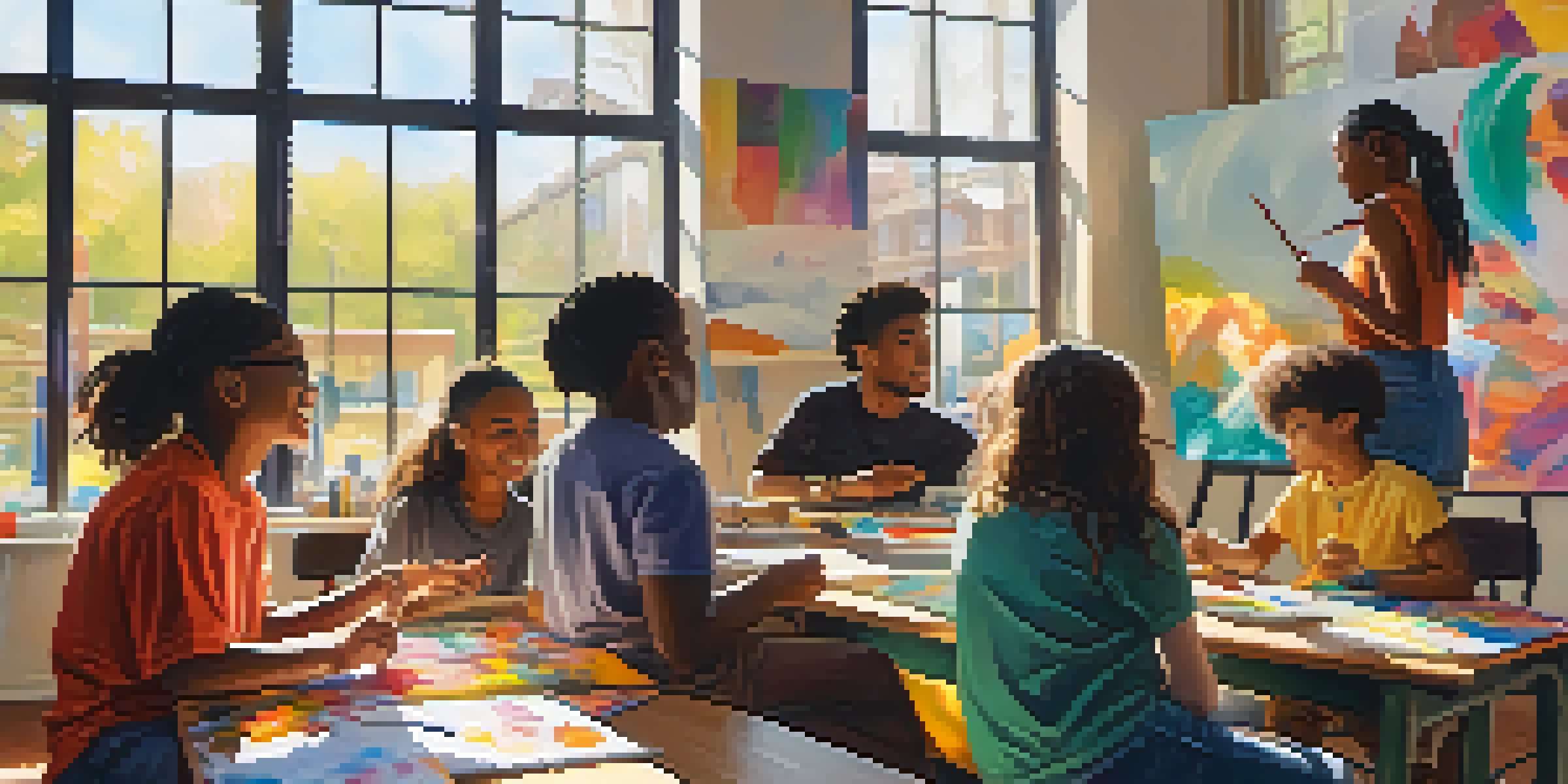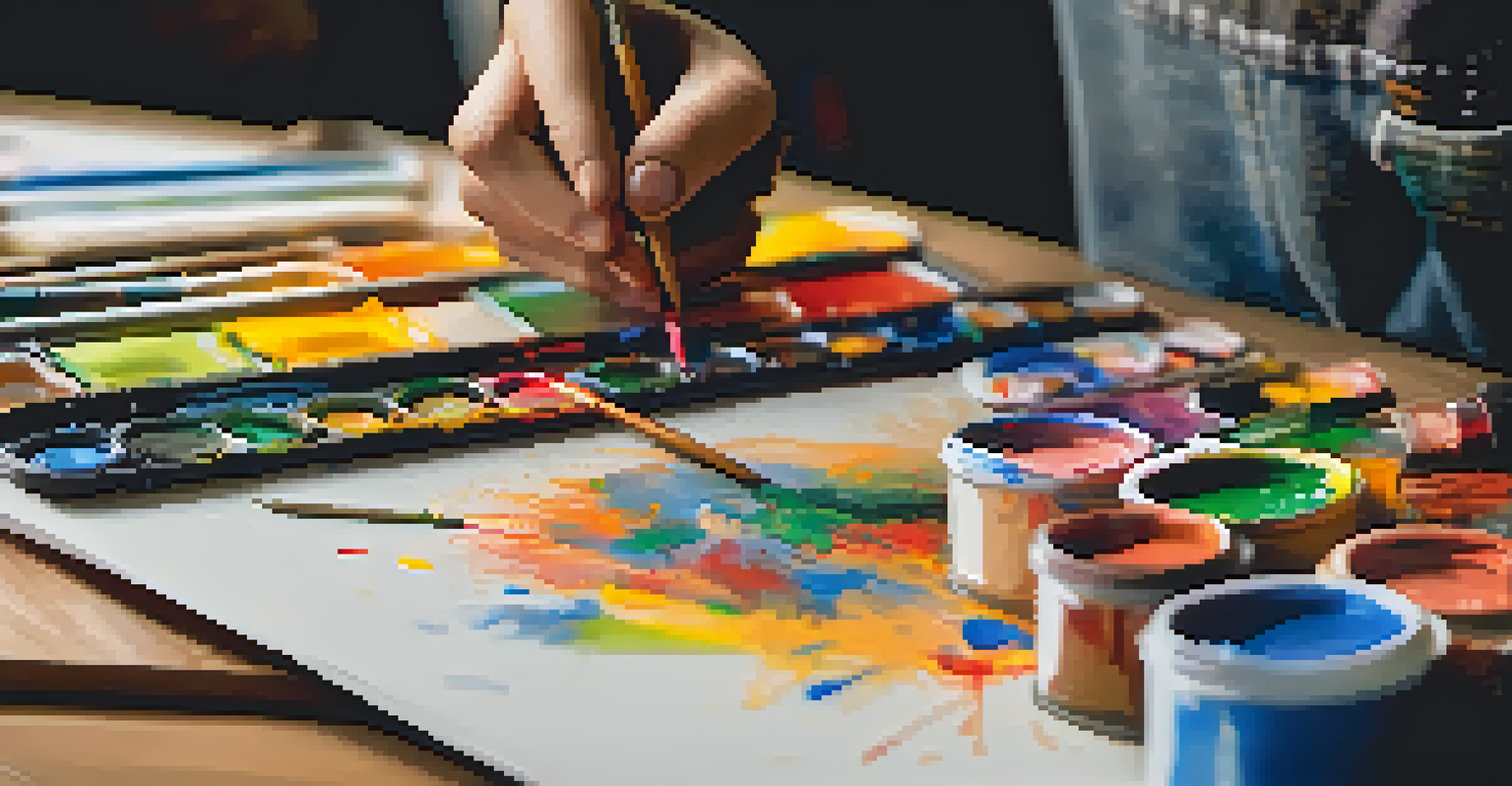Art Education as a Tool for Cultural Awareness in Students

Understanding the Role of Art in Culture
Art is a mirror reflecting the values, beliefs, and traditions of a culture. Through various forms—like painting, music, and dance—students can explore the rich tapestry of human expression. This exploration helps them appreciate not just their own culture but also those of others, fostering an environment of curiosity and respect.
Art is the most beautiful of all lies.
For example, when students study indigenous art forms, they gain insights into the histories and stories that shape those communities. This knowledge can spark conversations about cultural identity and heritage, helping students see the world through a broader lens. By understanding the context behind artworks, they learn to appreciate the diversity that exists in artistic expression.
Ultimately, art serves as a bridge connecting different cultures, encouraging students to engage with and celebrate differences. It enables them to realize that while cultures may differ, the emotions and experiences conveyed through art are universal, promoting empathy and understanding.
Benefits of Integrating Art Education in Schools
Integrating art education into the curriculum can significantly enhance students' cultural awareness. When students participate in art-related projects, they develop skills such as critical thinking and creativity, which are essential in understanding complex cultural narratives. These skills allow students to analyze and interpret various forms of artistic expression more deeply.

Moreover, art projects often encourage collaboration among students from diverse backgrounds. Working together on creative tasks fosters teamwork and communication, breaking down barriers that might exist outside the classroom. This collaborative spirit nurtures a sense of community while helping students appreciate different perspectives.
Art Enhances Cultural Awareness
Integrating art education into schools helps students appreciate diverse cultures and develop critical thinking skills.
In addition, art education can serve as a platform for discussing social justice issues and historical events that shape cultures. By examining art that addresses these topics, students can engage in meaningful dialogues, enhancing their awareness and understanding of the world around them.
Art Education as a Tool for Empathy Development
One of the most significant benefits of art education is its ability to foster empathy among students. When students create or study art, they often immerse themselves in the experiences of others, developing a deeper understanding of different cultural narratives. This emotional connection is crucial in cultivating a more compassionate worldview.
Art enables us to find ourselves and lose ourselves at the same time.
For instance, by analyzing artwork from various cultures that depict struggles, triumphs, and everyday life, students can relate to the emotions expressed by the artists. This relatability encourages them to see past cultural differences and recognize shared human experiences, such as love, loss, and joy.
Empathy gained through art education can translate into real-world actions, as students become more inclined to support social causes and advocate for marginalized voices. By understanding and valuing different perspectives, they become more engaged citizens, ready to contribute positively to a multicultural society.
Exploring Diverse Artistic Traditions
Art education provides students with the opportunity to explore diverse artistic traditions from around the globe. By studying various art forms, such as African masks, Asian calligraphy, or European Renaissance paintings, students gain insights into the cultural significance behind these works. This exploration broadens their horizons and instills a sense of appreciation for artistic diversity.
Moreover, understanding the historical context of different art forms helps students connect with the past, uncovering how cultural movements shaped societies. This knowledge enriches their learning experience, allowing them to see art not only as a form of expression but as a historical document that reveals much about humanity's journey.
Empathy Through Artistic Expression
Art education fosters empathy by allowing students to connect emotionally with different cultural narratives.
As students engage with these diverse traditions, they are encouraged to create their own art inspired by what they learn. This hands-on approach not only deepens their understanding but also celebrates the interconnectedness of cultures through creativity.
Promoting Cultural Exchange Through Art Projects
Art projects that encourage cultural exchange can significantly enhance students' understanding of global issues. For instance, collaborating with students from different countries on a shared art project allows for firsthand experiences of cultural practices and perspectives. This exchange fosters a sense of global citizenship among students, preparing them for an increasingly interconnected world.
When students participate in virtual art exchanges, they can share their unique cultural expressions while learning about others. This interaction not only enriches their artistic skills but also promotes respect and understanding for different ways of life and viewpoints.
Such collaborative projects can culminate in exhibitions showcasing the students' work, highlighting the beauty of cultural diversity. This not only empowers students but also encourages the wider community to engage with and appreciate different cultures.
Challenges in Implementing Art Education for Cultural Awareness
While the benefits of art education for cultural awareness are clear, there are challenges in its implementation. Budget constraints and a lack of resources can limit access to quality art programs, particularly in underfunded schools. This disparity can hinder students' opportunities to explore and appreciate diverse cultures through art.
Additionally, educators may feel unprepared to teach art in a way that effectively promotes cultural awareness. Professional development opportunities focusing on culturally responsive teaching and art education can help bridge this gap, equipping teachers with the necessary tools and confidence to guide students.
Challenges in Art Education Access
Budget constraints and limited resources pose significant challenges to implementing effective art education programs.
Overcoming these challenges requires a collaborative effort from schools, communities, and policymakers. By prioritizing art education and its role in fostering cultural awareness, we can create inclusive environments where every student has the opportunity to engage with the richness of global cultures.
The Future of Art Education and Cultural Awareness
As we look to the future, the role of art education in promoting cultural awareness is more important than ever. With globalization and the digital age, students are increasingly exposed to diverse cultures. Art education can play a critical role in helping them navigate this complexity, fostering understanding and appreciation among different communities.
Innovative teaching methods, such as integrating technology with traditional art practices, can enhance students' learning experiences. Virtual reality experiences, for instance, allow students to immerse themselves in different cultural environments, deepening their understanding of global art forms and traditions.

Ultimately, by investing in art education, we are investing in culturally aware future leaders. These students will be equipped not only with artistic skills but also with the empathy and understanding necessary to thrive in a diverse world.